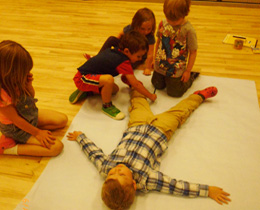Children’s voices at Victoria Quay Nursery
How to use this exemplar to improve practice?
The emphasis on this exemplar is how settings can provide learning experiences which provide opportunities for children to work together, express their views, influence decision-making and achieve change.
Staff could consider this example in the context of how they currently encourage children to work collaboratively. They could also consider opportunities children have to express their views and make choices. This can be on a daily basis as part of everyday life in the nursery, for example through play, choosing resources and activities, circle time, having a say in routines to the wider context of being involved in whole nursery decisions.
As a staff group you could reflect how your routines and wider decisions are agreed and identify opportunities for further involvement with children and others to ensure that all stakeholders are included in the improvement journey.
Reflective / Challenge questions to consider:
- How well are we enabling children to become independent learners and develop the four capacities?
- Do we create opportunities to enable children to make informed choices about their learning?
- In what ways and to what extent do our children make choices and decisions about their play and learning?
- Do children have an opportunity to develop a positive attitude to learning through active involvement in real-life and imaginary situations?
- In what ways and to what extent are children able to resolve conflict?
Download(s)
PDF file: Practice exemplar (109 KB)
What was done?
 Prior to posts being advertised staff gather children's views on the skills and qualities they think early education and childcare practitioners should possess. This is used to create a giant image of the ideal candidate.
Prior to posts being advertised staff gather children's views on the skills and qualities they think early education and childcare practitioners should possess. This is used to create a giant image of the ideal candidate.
The children work collaboratively, taking turns at drawing, talking and listening. They identify a wide range of attributes, which are scribed and written around their drawing.
Using their ideal candidate as stimuli, the children think about what kind of questions they would like to ask someone who wanted to work in their nursery.
Children are then supported to video one another asking the questions they had decided to ask.
The qualities and skills that children identified, and the actual videos of them asking their questions, are used during interviews for new early learning and childcare practitioners. The ways in which the children's input and contributions have been used as part of the interview process are fully explained to the interviewees, so that they understood the impact of the children's participation.
Why?
Children’s rights was a key focus for improvement within the setting.
What was the impact?
Involving children in the recruitment process demonstrated that children's opinions are valued by adults and that their participation can influence real-life decision making. This process of involvement promoted children's development as active learners.
The activities required children to work collaboratively. This increased their ability to take turns and developed a greater awareness of when to talk and when to listen. Encouraging all of the children to express their views and share their ideas supported them to grow in confidence and attain higher levels of positive self-esteem.
Through staff really listening to the children's voices and taking their views more fully into account, the recruitment process was greatly improved.
Staff continue to promote children's participation in the recruitment process by:
- Embedding the good practice that currently exists within the recruitment procedures
- Creating a booklet on participation to share with parents
- Working with children to explore different methods and tools to further promote their participation in staff recruitment
- Developing opportunities for children to play an active role in the induction of new staff within the nursery
- Devising a staff training pack to document children's participation.
